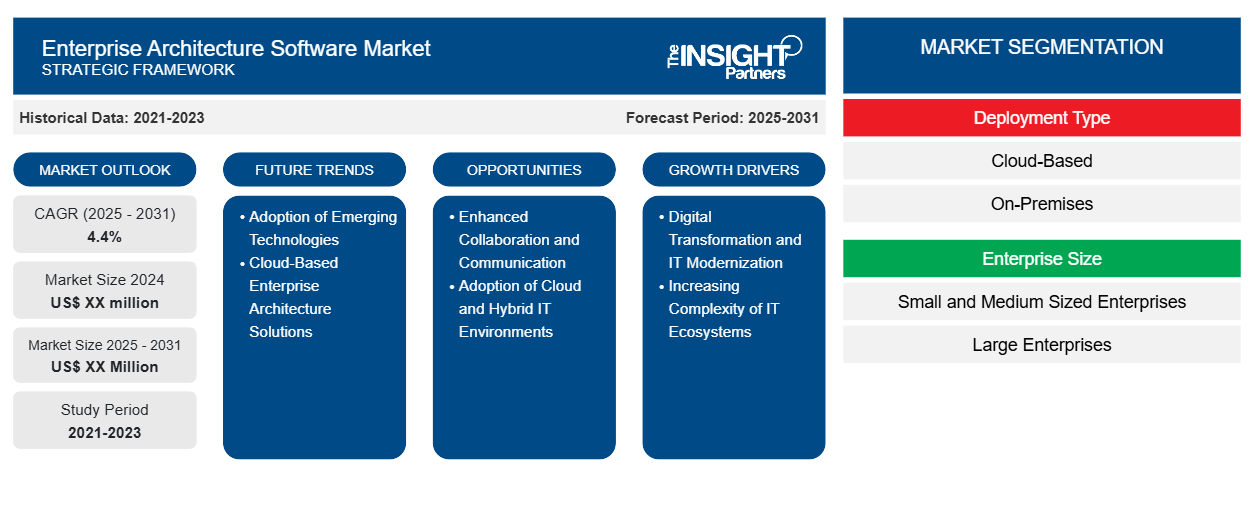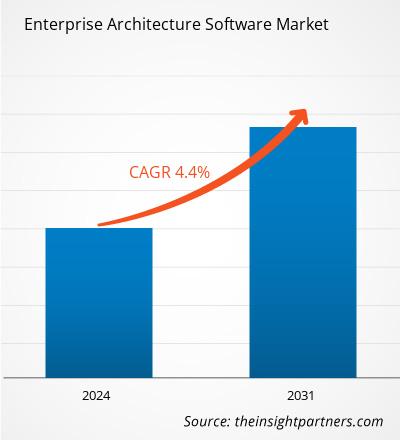The Enterprise Architecture Software Market is expected to register a CAGR of 4.4% from 2025 to 2031, with a market size expanding from US$ XX million in 2024 to US$ XX Million by 2031.
The report is segmented by Deployment Type (Cloud-Based, On-Premises); Enterprise Size (Small and Medium Sized Enterprises, Large Enterprises). The global analysis is further broken-down at regional level and major countries. The Report Offers the Value in USD for the above analysis and segments.
Purpose of the Report
The report Enterprise Architecture Software Market by The Insight Partners aims to describe the present landscape and future growth, top driving factors, challenges, and opportunities. This will provide insights to various business stakeholders, such as:
- Technology Providers/Manufacturers: To understand the evolving market dynamics and know the potential growth opportunities, enabling them to make informed strategic decisions.
- Investors: To conduct a comprehensive trend analysis regarding the market growth rate, market financial projections, and opportunities that exist across the value chain.
- Regulatory bodies: To regulate policies and police activities in the market with the aim of minimizing abuse, preserving investor trust and confidence, and upholding the integrity and stability of the market.
Enterprise Architecture Software Market Segmentation
Deployment Type
- Cloud-Based
- On-Premises
Enterprise Size
- Small and Medium Sized Enterprises
- Large Enterprises
You will get customization on any report - free of charge - including parts of this report, or country-level analysis, Excel Data pack, as well as avail great offers and discounts for start-ups & universities
Enterprise Architecture Software Market: Strategic Insights

-
Get Top Key Market Trends of this report.This FREE sample will include data analysis, ranging from market trends to estimates and forecasts.
Enterprise Architecture Software Market Growth Drivers
- Digital Transformation and IT Modernization: As organizations transition to a digital form, IT infrastructure must be modernized. EA software helps businesses visualise, manage, and optimize their IT landscapes and ensure that technology is deployed in accordance with strategic business objectives. A move towards cloud computing necessitates the reengineering of traditional IT architectures. EA software gives organizations the framework by which they may transition seamlessly into cloud-based systems while integrating them into on-premises infrastructures and effectively managing hybrid IT environments.
- Increasing Complexity of IT Ecosystems: Most enterprises have a combination of legacy systems, on-premises infrastructure, and cloud solutions. EA software is what helps manage this complexity by providing the integration of diverse technologies into a unified architecture that supports business objectives. The increased adoption of multiple technologies such as cloud platforms, IoT, AI, and microservices increases the complexity of enterprise systems. It helps businesses to manage, optimize, and integrate such technologies for an overall holistic view of the IT ecosystem.
Enterprise Architecture Software Market Future Trends
- Adoption of Emerging Technologies: The increasing use of emerging technologies such as the Internet of Things (IoT), Artificial Intelligence (AI), and Machine Learning (ML) requires new architectural frameworks that support their deployment and integration into existing IT ecosystems. EA software helps businesses design and manage these advanced technologies by providing a structured approach to their implementation.
- Cloud-Based Enterprise Architecture Solutions:The Enterprise Architecture Software market will see a shift towards cloud-based solutions, offering greater flexibility, scalability, and cost-efficiency. Cloud platforms will enable real-time collaboration, centralized data management, and seamless integration with other enterprise systems. This trend will drive faster implementation, enhance operational efficiency, and support businesses in adapting to digital transformation initiatives across industries.
Enterprise Architecture Software Market Opportunities
- Enhanced Collaboration and Communication : Enterprise architecture provides a common framework and language for IT, business, and operations teams to communicate and collaborate better. This is especially important in large organizations where various departments and business units need to work together toward common goals. EA software helps organizations document their architecture, processes, and systems, which can be shared across the organization to foster collaboration, streamline onboarding, and facilitate knowledge transfer.
- Adoption of Cloud and Hybrid IT Environments:The Enterprise Architecture Software market has a significant opportunity as businesses increasingly adopt cloud and hybrid IT infrastructures. These architectures require robust software solutions to manage complexity, ensure integration, and optimize resource allocation. This trend will drive demand for enterprise architecture tools that support cloud adoption, digital transformation, and seamless integration across diverse IT environments.
Enterprise Architecture Software Market Regional Insights
The regional trends and factors influencing the Enterprise Architecture Software Market throughout the forecast period have been thoroughly explained by the analysts at The Insight Partners. This section also discusses Enterprise Architecture Software Market segments and geography across North America, Europe, Asia Pacific, Middle East and Africa, and South and Central America.
Enterprise Architecture Software Market Report Scope
| Report Attribute | Details |
|---|---|
| Market size in 2024 | US$ XX million |
| Market Size by 2031 | US$ XX Million |
| Global CAGR (2025 - 2031) | 4.4% |
| Historical Data | 2021-2023 |
| Forecast period | 2025-2031 |
| Segments Covered |
By Deployment Type
|
| Regions and Countries Covered |
North America
|
| Market leaders and key company profiles |
|
Enterprise Architecture Software Market Players Density: Understanding Its Impact on Business Dynamics
The Enterprise Architecture Software Market is growing rapidly, driven by increasing end-user demand due to factors such as evolving consumer preferences, technological advancements, and greater awareness of the product's benefits. As demand rises, businesses are expanding their offerings, innovating to meet consumer needs, and capitalizing on emerging trends, which further fuels market growth.

- Get the Enterprise Architecture Software Market top key players overview
Key Selling Points
- Comprehensive Coverage: The report comprehensively covers the analysis of products, services, types, and end users of the Enterprise Architecture Software Market, providing a holistic landscape.
- Expert Analysis: The report is compiled based on the in-depth understanding of industry experts and analysts.
- Up-to-date Information: The report assures business relevance due to its coverage of recent information and data trends.
- Customization Options: This report can be customized to cater to specific client requirements and suit the business strategies aptly.
The research report on the Enterprise Architecture Software Market can, therefore, help spearhead the trail of decoding and understanding the industry scenario and growth prospects. Although there can be a few valid concerns, the overall benefits of this report tend to outweigh the disadvantages.
Frequently Asked Questions
What are the options available for the customization of this report?
What are the deliverable formats of the Enterprise Architecture Software market report?
What are the future trends of the Enterprise Architecture Software market?
What are the driving factors impacting the Enterprise Architecture Software market?
What is the expected CAGR of the Enterprise Architecture Software market?
- Historical Analysis (2 Years), Base Year, Forecast (7 Years) with CAGR
- PEST and SWOT Analysis
- Market Size Value / Volume - Global, Regional, Country
- Industry and Competitive Landscape
- Excel Dataset
Recent Reports
Related Reports
Testimonials
Reason to Buy
- Informed Decision-Making
- Understanding Market Dynamics
- Competitive Analysis
- Identifying Emerging Markets
- Customer Insights
- Market Forecasts
- Risk Mitigation
- Boosting Operational Efficiency
- Strategic Planning
- Investment Justification
- Tracking Industry Innovations
- Aligning with Regulatory Trends





















 Get Free Sample For
Get Free Sample For